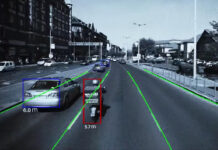The recent buzz around solar storms—and issues surrounding GNSS signal disruption—have prompted the industry to seek solutions for mitigation. Due to Solar Cycle 25, the world is experiencing higher-than-usual solar activity on Earth, which will peak through the remainder of 2024 and into 2025.
Location Business News recently interviewed Stuart Riley, Trimble’s $TRMB vice president of technology, to discuss how solar storms could potentially devastate the U.S. power grid and communications systems—and cause a major impact on the integrity of GNSS worldwide.
LBN: These recent Northern Lights viewings also showed potential GPS interference. What kind of interference could happen?
Riley: “Increased solar activity can impact the ionosphere, and we see several effects. During severe activity, we may observe rapid fades in the signal. This can lead to reduced tracking signal strength and ultimately lead to short losses of lock (the ability to track satellites). We can also experience additional noise on the carrier measurement, which can impact the quality of the RTK solution. Overall, the delay through the ionosphere is greater around the solar max, so GNSS receivers that use models for ionospheric correction may experience more errors depending on the quality of the models. We may also observe increased decorrelation of ionosphere between base and rover for RTK or differential systems.
“More generally, severe storms can damage satellites, like we see here. A Starlink launch a few years ago was distributed as a solar storm increased solar drag resulting in the loss of 40 satellites. On the surface of the earth, severe storms can have an impact on the power grid. For example, the 1989 storm impacted Canada’s power grid. The varying magnetic field caused by the solar storm interacts with the long wires and transforms of power systems:
“The solar storm with the most impact on the earth in recorded history was the Carrington event in 1859. Relative to this storm, the recent May storm was relatively mild – from NOAA’s space weather prediction site.”
LBN: Will these solar disruptions become more frequent in the next few years?
Riley: “Approximately every 11 years, the magnetic poles on the sun flip. As the magnetic field changes, it causes regions of instability known as sunspots. Coronal Mass Ejections (CMEs) are explosions of plasma from the sun and are often emitted from the unstable sunspot regions. If they are earth-pointing, there’s a chance they will reach the Earth and interact with the Earth’s magnetic field. They are seen visually as the auroras at the north and south poles. CMEs are correlated with the number of sunspots (the more sunspots, the more chance of a CME). Therefore, we can review the number of visible sunspots to get an idea of the potential for ionospheric instability. During the peak of the solar cycle, there are solar storms that impact the earth every one to two weeks. However, storms of the magnitude of the 10th of May are very rare. This was the most severe storm since around Halloween 2003.
“Fortunately, we have a very long-time series of sunspots, so we can put the current cycle into context. However, as each cycle is around 11 years, the penetration of GNSS into industrial and everyday life has increased significantly since the last cycle. The current cycle is relatively modest compared to some of the historical cycles. If we look more closely at the current cycle, Solar Cycle 25, we can see the recent history along with predictions for the rest of this solar cycle. You’ll see several models, all with slightly different peak forecasts, which range from late 2024 thru to mid-2025.
“For the last two to three years, we’ve had customers in some regions that have experienced problems due to the increased ionospheric activity (north Canada, northern Nordic and South America). This is likely to continue for the next couple years. Frequent solar storms will continue for a while. However, most are likely to only extend to the most northern regions of CONUS and Europe, although significant storms are possible.
“The recent storm was caused by CMEs from sunspot AR3664. This was a huge sunspot, around the size of 15 earth diameters. A complete rotation of the sun is on the order of 30 days, and this sunspot was on the far side of the sun for the last few weeks, but has now reappeared. However, it is now much smaller than before, though it continues to be active.
“We shouldn’t forget that ionospheric effects are not only constrained to the polar regions. The geomagnetic equator dips through Brazil. In this region, the ionosphere is less impacted by solar storms. Around the peak of the solar cycle, between the months of around September and March, at local dusk, the ionopshere becomes unstable and impacts GNSS signals that pass through it for a few hours. Below is a plot that shows this effect at a Trimble station in Brazil. The color represents the intensity of the ionospheric impact on GPS. White is missing data. We clearly see the seasonal impact. This has had a significant impact on mining and farming. Some other industries are less affected as they are less reliant on precision positioning during the evening/night.”
LBN: What measures do Trimble equipment do to fight these types of interferences and disruptions?
Riley: For about three years, Trimble has been working towards improving our precision positioning solutions during high ionospheric activity. Since the last solar storm, there have been several enhancements that already improve our position solution during ionospheric activity. We’ve introduced the ProPoint positioning engine and improved the signal processing.
- The signal processing now reacquires the signals after a loss of loss through to the tracking quality required for RTK faster than before, especially for modern GNSS signals that have pilot signals (available on many of the modern GNSS signals).
- Signals from a satellite are now tracked with more independence than before. For example, if GPS L1 C/A fades, we can continue to track and use L2C and/or L5. Research has shown that the fades on L1, L2, L5, etc are not necessarily correlated, so during ionospheric activity, the signals on each band won’t necessarily fade at the same time.
- ProPoint is more agnostic to signal type/frequency than our earlier engine. If L1 is not available, it can use signals from other bands and dynamically implement one, two, or three-frequency RTK for each satellite independently.
- Overall ProPoint is a more robust positioning engine.
“Specific to IonoGuard, Trimble estimates three ionospheric-related parameters for each satellite. These parameters are used on a satellite-by-satellite basis to adjust the position engine to optimally process the data during ionospheric activity. We’ve also made some adjustments to the signal processing to better track signals during high ionospheric activity.
“With the improvements we’ve made since the last solar cycle, along with the targeted IonoGuard enhancements, in many cases, we have observed positions that were previously degraded to decimeter or worse continue at the centimetric level during the storm, which can be seen here. This is a site in Northern Canada. Historically, it has been a challenging site during geomagnetic storms. Since installing IonoGuard at this site, we’ve seen a significant improvement in the position performance. Trimble now reviewed data at multiple sites in the U.S., Nordic region and mainland Europe, and this remains the most impacting site we’ve observed during the last storm. You’ll see that even during this storm, the Trimble RTK engine continued to deliver high-quality measurements.
“Below is an example from Sweden from the May 10th storm. The storm hit late on this date (time is UTC). We see that the IonoGuard solution (released in October 2023) provides a significantly improved position relative to the ProPoint only.
“Note that, despite the impressive auroras in Europe, RTK datasets Trimble has reviewed in mainland Europe (excluding Nordic and the UK) showed much less impact than this higher latitude Swedish example. While IonoGuard did help in mainland Europe, in general, we saw existing ProPoint deliver much better solutions than we observed in this Swedish example. When we reviewed the ionospheric quality indicators (the three metrics ProPoint is estimating for each satellite), we saw more impact in the California Bay Area (37N) than in Munich (48N). This is likely due to a number of factors, including the U.S. pointing at the sun when the stronger CMEs hit the Earth.
“Future storms may have a very different impact. As this storm hit on Friday later in the day and extended into the weekend, there was likely less economic activity that relied on precision GNSS. This may change in the future as GNSS is increasingly used in autonomous systems.”




























